
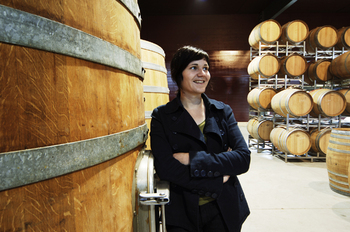 |
| The Judith Beck estate is based in the Burgenland commune of Gols, in the Neusiedlersee region, on the eastern – and warmest — side of the Lake Neusiedl. Gols is part of the larger Burgenland region in easternmost Austria, which enjoys a very warm climate defined by the Pannonian plain to the east and the Lake. Lake Neusiedl’s depth is only 1.5 meters and its water temperature can reach 90 degrees F. in the summer. Indeed, this is Austria’s warmest wine growing area, the first to harvest, and the production center of its finest full-bodied, dry red wines. Judith’s parents, Matthias and Christine Beck, founded the family estate in 1976. Judith Beck made her first vintage in 2001 and in 2004 she assumed full control of the winery. After graduating from the Klosterneuburg Viniculture College Judith Beck gained international experience at world-renowned wineries, including Chateau Cos d’Estournel in Bordeaux, Braida in Piedmont and Errazuriz in Chile. Managing the family winery comes naturally to Judith who has an innate “sixth-sense” feel for the regional varieties Zweigelt, Blaufrankisch and St. Laurent. Judith Beck owns a total of 13.5 hectares of vines in Gols, with holdings in the vineyard sites of Altenberg, Gabarinza, Salzberg and Schafleiten. 85% of the area is planted to red varieties – Blauer Zweigelt, Blaufrankisch, St. Laurent, Pinot Noir and Merlot, with the remaining 15% planted to white varieties – Welschriesling, Pinot Blanc and Chardonnay. In addition, grapes are brought in from another 5 hectares in the communes of Apetlon, Halbturn and Winden, and used in the production of the basic red wines. Vines are planted at high densities of up to 7,000 vines per hectare to limit yields and ensure ripe fruit at harvest time. Soils range from loam and clay on the lower vineyards to limestone, higher up on the ridges. The Becks built a new modern and functional winery and aging cellar in 2005. It allows Judith to manipulate her wines as little as possible in the vinification process, resulting in wines which show the pure and vivid expression of the varietal and the unique vintage character. Judith Beck’s wines are at once elegant, fruit forward and complex expressions of her vineyards, Farming/vinification practices: Judith and her father Matthias practiced sustainable viticulture from the outset, and converted to biodynamic practice with the 2007 vintage. Judith uses only native yeasts in the fermentation process. The red wines are fermented in temperature-controlled stainless steel tanks, in new barriques or in open vats. The wines undergo malolactic fermentation in new barriques or in large oak barrels. Some of the red wines are also matured in large oak vats, some of which are quite old, and are already being used by the third generation of owners.The wines are vegan. The estate is a member of the Pannobile association, as well as of “11 Frauen und ihre Weine” (11 Women and their Wines). The philosophy of the domaine is aptly put by Judith: “Wine and the joy of living and pleasure all go hand in hand. We prefer wines which captivate all of our senses with each new bottle and each new sip.” |
| Judith Beck Website |
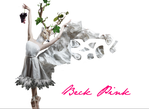 |
| Pink |
| 65% Zweigelt, 35% Blaufränkisch. The 2016 Pink does not include St Laurent, that was lost to frost at the end of April. The grapes were picked mid September. The fruit was all immediately pressed and fermented with native yeasts. The young wines developed on their lees in tank, with one racking; no malolactic fermentation. Medium rosy-pink in color with notes of cherry, raspberry and plum on the nose and palate. Light, dry and very fresh. 1.3 gr RS. 11% alcohol. |
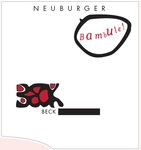 |
| Neuburger - "Bambule!" |
| The “Bambule!” lineup is the result of a very free-spirited approach: no treatments, additives, finings and so on. It is a logical consequence of Judith Beck's biodynamic work in the vineyard, and it gives her a chance to conduct a lot of experiments. By working with skin contact for the Bambule whites (several days and up to two weeks), she gets a lot of extra structure on the palate. In her area, the acidity of the white grapes can be quite low, so they need that extra structure. Neuburger is an old, very traditional white grape variety of Austria. It was not very popular in the nineties and that’s why it almost disappeared. Judith's parents used to have 25 % of their vineyards planted with Neuburger, but there was none left when Judith took over. She decided in 2008 to replant just under one-half hectare. She now has a small vineyard called Hochraitacker. It is a south-west exposed slope with gravelly soil, very near the Altenberg, on the western part of Gols. The 2015 Neuburger was picked by hand on September 2nd. The grapes were destemmed and slightly crushed by foot. Then the juice macerated for 5 days on the skins. After that it was pressed and racked into seven 10-12 year old, neutral, barriques where it did both alcoholic and malolactic fermentation. It was kept on its entire lees for 1 year, without any stirring of the lees to enhance freshness. It was bottled on August 28th 2016 without any fining or filtration. 2000 bottles produced. |
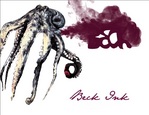 |
| Beck - "Ink" |
| 80% Zweigelt, 20 % St. Laurent. "Ink" is a fresh and juicy red fermented in stainless steel tanks, then aged in large casks. 12.5% Alcohol. |
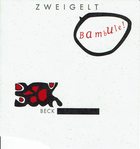 |
| Zweigelt - "Bambule!” |
| The “Bambule!” lineup is the result of a very free-spirited approach: no treatments, additives, finings and so on. It is a logical consequence of Judith Beck's biodynamic work in the vineyards, and it gives her a chance to conduct a lot of experiments. For the reds, she tries to achieve great freshness by eschewing pump-overs or punch-downs, so that the tannins always stay fresh and smooth. The grapes for Zweigelt Bambule come from a one-half hectare, mid-slope parcel Judith owns in the Kurzberg vineyard, which is near the winery, just west of Gols. The site was planted in 2007. It is a south-west exposed slope with a sandy loam and limestone soil. The grapes are taken from the middle part, not from the plateau on top and not from the bottom, because they are the ripest. They give Judith the perfect ripeness without having too much sugar. She is looking for freshness and ripeness in the Zweigelt Bambule and gets that freshness by doing a special vinification. The grapes were picked on September 17th 2015. The tops were removed off four, 500 litre barrels that are 4-8 years old, for the fermentation. The 500L barrels were positioned directly underneath the de-stemmer; this allows the grapes to fall directly into the upright barrels. (the winery was equipped with a new destemmer in 2015 which works very gently and almost all the berries are intact.) Then CO2 is added, the barrels are closed with a plastic sheet and left upright for three weeks. Nothing is touched; there is no mechanical extraction. A simultaneous alcoholic fermentation with native yeasts of the juice from the berries that have burst open, and a carbonic maceration within intact the berries take place. Judith likes this method very much, because she thinks that everything needed is extracted, but never too much. This means that the tannins are very smooth and balanced. After three weeks, the wine is pressed with a small basket press and racked into seven, 8-10 years old Barriques. The juice is still very sweet at this point because of the intact berries. The largest part of the fermentation happens only after pressing in the Barriques. The alcoholic fermentation period lasted 10 days and the malolactic fermentation followed spontaneously. The wood tops are put back on the barrels after pressing and the same casks are used for the aging period. The Zweigelt Bambule 2015 was assembled in tank and bottled end of June 2016, without any fining or filtration. Total production was 2000 bottles. |
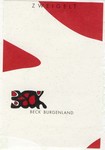 |
| Zweigelt |
| At 2500 cases this is Beck’s largest single production. She picks from vineyard sites in Halbturn, Apetlon and Gols. The soils are sandy-limestone-gravel (Seewinkelschotter). Judith Beck and her team pick all of the fruit by hand and sort the grapes in the vineyard and at the winery before de-stemming. Fermentation occurs spontaneously, triggered only by the grapes’ native yeasts, in stainless steel tanks. Beck circulates the fermenting juice over the cap of grape skins twice per day for the first 10 days to attain a balanced level of extraction. The young wine is then racked off its skins and moved into 1000-2000 liter, neutral acacia wood casks for two months where it completes its malolactic fermentations. It is then transferred to 4-6 year old barriques for 8-10 months of aging. Beck matures her Zweigelt in two phases in wood in order to attain the round, complex and vivid style she seeks. The Zweigelt is assembled and bottled in July Bright, dark cherry, black-currant and spicy aromas and flavors with a fresh, berry-fruit finish. |
 |
| Blaufrankisch |
| In general, Blaufrankisch is picked later than Zweigelt and has thicker skins; versaison is about 1 week later. For her first Blaufrankisch she selects from different vineyard sites in Halbturn and Gols; the vines average 15 years old. The soils are known as Seewinkelschotter, sandy-limestone-gravel. Judith Beck and her team pick all of the fruit by hand and sort the grapes in the vineyard and at the winery before de-stemming. Fermentation occurs spontaneously, triggered only by the grapes’ native yeasts, in stainless steel tanks. Beck circulates the fermenting juice over the cap of grape skins twice per day for the first 10 days to attain a balanced level of extraction. The young wine is then racked off its skins and moved into 1000-2000 liter, neutral acacia wood casks for two months where it completes its malolactic fermentations. It is then transferred to 4-6 year old barriques for 8-10 months of aging. Beck matures her Blaufrankisch in two phases in wood in order to attain the round, complex and vivid style she seeks. The Blaufränkisch is assembled in September. Beck makes only 500 cases of this Blaufrankisch and it is superb. it has a chewy, plush texture with generous dark cherry, cassis and plum fruit nuanced by herbs and a touch of minerality. It is a highly versatile wine, complementing virtually all types of food and cuisines. 12.5% alcohol. |
 |
| Blaufrankisch Altenberg |
| From a single vineyard, Altenberg - sandy loam and limestone soil - spontaneous fermentation in open wooden vats, malolactic fermentation in barriques - aged for 20 months in Barrique, 50% new oak, then a further 12 months in bottle before release Dark ruby with violet rim, not yet fully developed on the nose, wild berries and herbal spiciness, very long on the palate, good acidity, fine tannins, elegant and balanced, long finish, much ageing potential - 13,0 % alcohol |
 |
| Heideboden |
| The Heideboden is Judith's signature blend of 50% Zweigelt, 20% Blaufränkisch, 20% St Laurent, and 10% Merlot. The bio-dynamically grown fruit is selected from vines averaging 20 years of age on the estates’ finest hillside vineyards (the older vines in these sites are used for her Pannobile wine.) The altitude is between 135-150 meters, which is relatively high for the area. The soils here contain a large proportion of gravel mixed with sandy loam and limestone. Beck harvests each variety by hand in order of ripeness: St Laurent first, followed in intervals of about 7 days each by Zweigelt, Blaufränkish and Merlot. The grapes are sorted in the vineyard and then twice at the winery – before and after de-stemming -- on a sorting table. Each variety is vinified separately in stainless steel tanks with regular pumping over as the alcoholic fermentation proceeds. No yeast is added and the fermentation begins spontaneously. When the fermentation has concluded, Beck gives the young wine a 3- week maceration period in tanks with no pumping over. Half of the volume is then transferred to 2000 litre acacia casks and the other half to neutral, 3-5 year old 225 litre barriques for twelve months of maturation. Judith assembles the varieties in tank when they have come to fully express their character for the vintage and bottles about one month later. Beck’s Heideboden is a generous, multi-layered complex wine, with notes of sweet blackberry cassis and minerals with a long and bright finish of ripe fruit and spices. It merits cellaring for 3-5 years. |
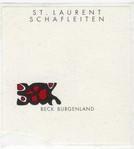 |
| St Laurent Schafleiten |
| The St Laurent Schafleiten is made from a 0.72 hectare parcel of 15 year old, bio-dynamically cultivated vines growing on a red gravel soil at the top of the slope above Gols. The Schafleiten vineyard, at about 150 meters altitude on the Parndorfer plateau, faces south-east. The micro-climate here is slightly cooler and windier, making it ideal for the St. Laurent variety which buds early and needs a long ripening cycle but never exceeds 12.5% in alcohol. The vines are planted densely at 5000 plants per hectare and yields are a very low 25-30 hectoliters per hectare. Beck harvests by hand, sorts the grapes in the vineyard and then twice at the winery – before and after de-stemming -- on a sorting table. She ferments the St. Laurent in open, 3500 liter wood vats using only the grape’s indigenous yeasts and punches down the cap by hand three times per day for the first week. The vatting period lasts for 3 weeks after which the wine is moved into barriques, which are 20% new and the rest are 1-4 years old. The St. Laurent undergoes malolactic fermentation in barrels, where it matures for 15 months before bottling. The Beck St. Laurent Schafleiten shares the freshness and soft, enveloping textural quality of a Pinot Noir from a warm year. But its fruit is darker and richer, alcohol level lower, and the tannins softer, making it a uniquely rich and elegant wine, with generous flavors of supple black cherry, wild blue and blackberry and spices. |
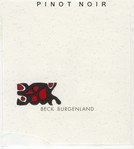 |
| Pinot Noir |
| |
| Copyright © 2002-2017 VOS Selections, Inc. |